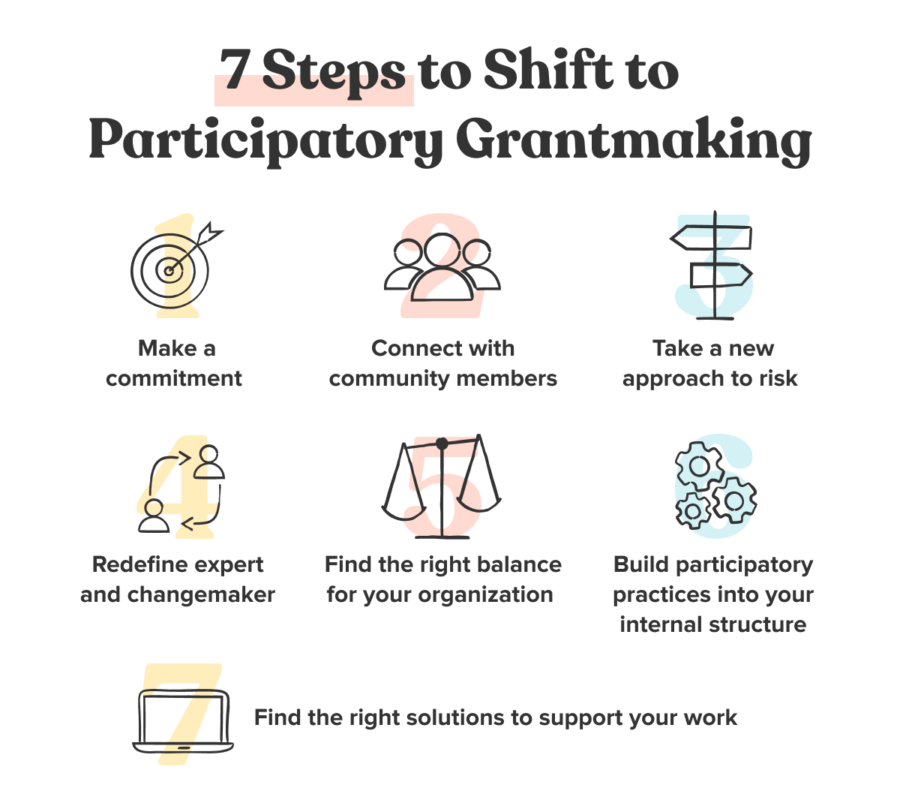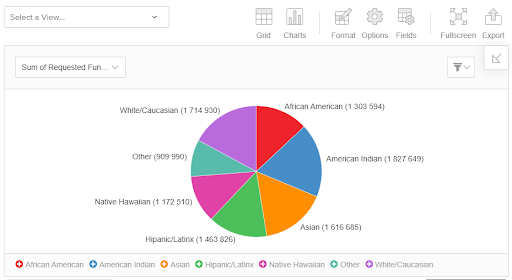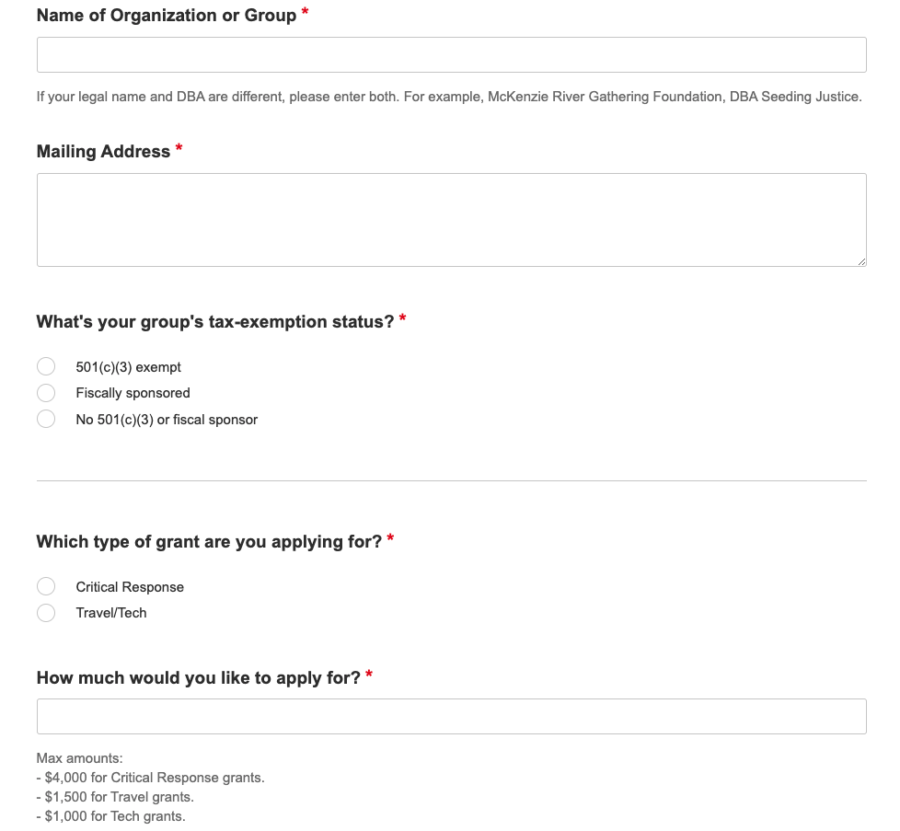Traditional philanthropy has a problem. The top-down, hierarchical power structure often undercuts efforts to make lasting change. In fact, the system itself can mirror the very conditions that created inequity and drove the need for charitable giving in the first place.
One of the biggest critiques is the divide between funders and grantees. So often there is a gap between the people being served and the ones calling the shots about how funds are distributed. Folks in the sector have long been voicing their concerns about this imbalance—and while arguably overdue, many funders are now actively taking steps to shift their practices.
One promising way forward is through participatory grantmaking. Participatory grantmaking reimagines the relationships and decision-making processes that shape programs and organizations.
In this article, we cover the benefits of participatory grantmaking and current trends. Plus we lay out the challenges as well as step-by-step instructions to help you transition your organization to a more community-centered model.

What is participatory grantmaking?
Participatory grantmaking is an approach to grantmaking that centers the community being served. Community members help design and drive programs. They are included in setting goals, making decisions about how to allocate resources, and evaluating success.
Participatory grantmaking breaks down the binaries that have become entrenched in traditional philanthropy. It closes the distance between funder and grantee. And it upends the notion that program recipients should be separate and distinct from decision makers.
This model of giving relies on the expertise of those with lived experience. Who knows a community’s challenges and strengths better than someone from within it?
For example, Brooklyn Community Fund seeks feedback from local leaders to set priorities. Rather than taking on a savior mentality and imposing an outside set of values, the organization supports the community’s self-determination. Brooklyn Community Fund invests in the agendas set by local residents and amplifies their voices.
Learn about the trust-based movement
Watch our webinar with Shaady Salehi of the Trust-Based Philanthropy Project.
Benefits of making the change
Addressing inequity
Traditional philanthropy has for centuries perpetuated inequity by favoring certain voices and further concentrating power. Shifting to participatory grantmaking is a means for your organization to address these imbalances. For example, charity and foundation boards are overwhelmingly white. This has contributed to skewing who gets funding and how much they get.
Moving to a participatory framework breaks this cycle of racial injustice by shifting the power to the communities. It’s an incredible vehicle to democratize philanthropy and tackle the inequities that have long been plaguing the sector.
For example, Seeding Justice has built their organization around participatory practices.
Philanthropy should be transparent and people-led, and rooted in community; should focus on over-resourcing the communities who have been and continue to be disenfranchised and left behind, and who, despite it all, continue to resiliently thrive; and should seek deep, systemic, and long-lasting change—not charity.
From the Seeding Justice website
Ensuring efficacy and longevity
Centering the community in your program design means understanding the values and needs of the folks you’re looking to serve. This connection gives you a much higher chance of building a meaningful and lasting program.
When folks feel engaged and listened to they are much more likely to participate. Community involvement and investment are keys to long-term success in grantmaking. If folks feel like your program is steamrolling community voices and imposing an outside set of values, it’ll be difficult for your organization to build trust.
Community members know best what works and what doesn’t. They have a deep understanding of how issues and solutions intersect, and likely they have witnessed past attempts to make change. Using a participatory model means that their expertise will shape your program. Not only will this help you sharpen your tactics, but it ensures that you’ll get honest feedback about the impact of your work.
Explore the broader efforts to decolonize philanthropy
Check out our Impact Audio podcast episode featuring author and activist, Edgar Villanueva.
Matching resources to needs
As a grantmaker, you’re delivering funds to the individuals and organizations that make change. By involving community members in designing your program, you can direct resources to the projects that address the most pressing needs. Getting feedback from those who know best prevents you from investing in the wrong approach.
For example, say you’re looking to improve educational outcomes for students in a certain neighborhood. Based on your experiences, perhaps you think a tutoring program would be a good approach. Without community input you might move forward with this idea—but what if there are more urgent needs that have even greater impact on student outcomes? What if food insecurity is a big issue? Or maybe kids do not have access to mental healthcare or trauma support. A tutoring program isn’t going to help much if these needs aren’t met first.
6 trends in participatory grantmaking
1. Understand that the process is part of the impact
Of course, distributing funds is a big aspect of how traditional philanthropy makes change. But in participatory grantmaking, money is only a piece of the story. The process itself is part of the impact. Empowering the community and enabling their self-determination is as meaningful as the resources they receive.
2. Commit to transparency
Being open and honest about how your organization operates is essential. Again, it’s not just about where the money goes, but about who holds the power. The public should be able to understand how decisions are made and who is making them. For instance, the Indigenous Women’s Flow Fund brings together five indigenous women from across the U.S. to form a cohort that makes decisions about grantmaking dollars. They shape the program for three years, and then a new cohort takes over.
3. Include the community in the full program lifecycle
Truly centering community members in decision making means involving them throughout the whole lifecycle of your grantmaking program. They should have a voice in designing strategy and setting priorities. They should also be a part of the review and evaluation process.

4. Operate on community timelines
It’s easy to get caught up in your schedule, whether you’re thinking about reporting to donors or stakeholders or building your program around other initiatives. But prioritizing the community means operating on their timeline even if it doesn’t quite sync up to yours. Rushing to meet artificial deadlines will hamstring your ability to build relationships. On the flip side, moving too slowly to address an urgent need can undermine your program.
5. Be open to a flat power structure
If you’re shifting from a traditional approach to grantmaking, you might be used to a top-down power structure with one person in charge. However, the community might have a more fluid or collective style of leadership. Be open to this structure and think less about who’s in charge and more about how folks are working together.
6. Prioritize diversity, equity, and inclusion
With philanthropy’s long history of inequity, supporting true diversity takes a concerted effort. It has to be a priority. And organizations need to be careful not to engage in tokenism—the practice of using people of color as the “face” of the organization without giving them meaningful power. Remember DEI is not a standalone initiative—it touches every part of your organization. Make tangible commitments, and use data to support and evaluate efforts.

Facing the challenges
As with any transformation, shifting to a new approach in your grantmaking does pose some challenges. Understanding these from the outset can help you set realistic expectations and keep unexpected issues from derailing your progress.
It takes time
Because participatory grantmaking is rooted in relationships, it can take time to get the pieces in place to support this transformation. You need to build community and establish trust—which is hard to do on a short timeline. Though you want to be proactive, do keep in mind that patience is part of the practice.
Rethinking power can be complex
As you work to connect with the community, it might be tricky to identify the right leaders and ensure participation. You’ll also need to be mindful to prevent past power dynamics from replicating themselves within a new system.

There’s no one “right” way
Unfortunately, it won’t work well to simply copy exactly what another organization is doing. The only way participatory grantmaking works is if you build the right system for your team, your mission, and the community you seek to serve. Of course, this can require more work on the front end. Sometimes experimenting is the best way to see what works, which can feel risky. But the payoff can be huge—check out how Mama Cash, an international women’s fund, went all in on a participatory model.
Letting go is part of the process
Your team will have to let go or scale back some of the formalized policies and structures that have likely become part of the organization’s identity. This process requires humility from everyone involved. Some folks will have to have to give up power that they’ve grown accustomed to, which might be an uncomfortable process.
A leap of faith is required
You’re building a whole new ethos for your grantmaking. It will take time to show results. Committing to this new model requires a leap of faith in some ways. Not everyone may be on board to make these big changes, and you’ll likely have to figure some things out along the way. Part of making this shift is getting accustomed to some discomfort as you and your team figure out the best way forward.
7 steps to get started
1. Make a commitment
Shifting your practices requires buy-in from all levels of your organization. Get your leadership behind the effort and give everyone on the team a chance to voice their questions and concerns.
Clarify your vision. What does a participatory approach look like for your organization? What changes are you hoping to make? Push beyond vague notions to set tangible goals to help you stay accountable. Be sure to plot out how a participatory approach aligns with your mission. This will help guide your work.
2. Connect with community members
Relationships are essential. If you don’t already have strong ties in the community, work to build those connections. Hold space for dialogue and lay out your plans for including new voices into your decision-making processes. Of course you want to be open to feedback, but feedback alone is not enough if final decisions remain in the same hands.
Approach these conversations with humility and be sure to listen more than you talk. You want community members to feel heard. This will help inspire them to show up and get invested in the work.
3. Take a new approach to risk
Perhaps in the past you required nonprofits to have a proven history of success before you would offer support. Maybe you even prioritized folks you worked with in the past or organizations that had secured certain credentials. Of course the impulse was likely to minimize risk, but that often leaves out emergent organizations. In turn, you might be ignoring a whole subset of the community that larger nonprofits aren’t able to reach.
Shift your understanding of risk so that you can support those local grassroots efforts even if they don’t have a history with your organization or slick promotional materials. Perhaps you need to eliminate certain requirements or restructure your grant application process. It’s also worth examining how unconscious bias can influence decisions around funding.

4. Redefine expert and changemaker
Breaking down the binary between community members and decision makers also means redefining who can make change. An expert is no longer a scholar or someone who’s had a long tenure in philanthropy. Instead it’s defined as someone with lived experience.
Change is not just an outside force, but comes from within the community. Redefining these terms will help your team center the right voices in their work. For example, Global Greengrants Fund follows the lead of community members and provides resources that folks on the ground may use however they see fit.
5. Find the right balance for your organization
The shift to participatory grantmaking doesn’t have to be all or nothing. Maybe you want to move to a purely peer-led model. Or perhaps you want staff and donors to be involved in some aspects of the work. Find the right balance for your team and mission.
You can also start small by implementing changes to one or two of your programs without overhauling all of the work you do. This gives you the opportunity to try out new ideas on a small scale before you integrate them more broadly. This toolkit has more resources to help you get started.
6. Build participatory practices into your internal structure
It’s difficult to switch to a more communal approach with grantees if your internal organization structure is still built on a top-down hierarchy. Think about how you can incorporate these new practices into your internal work. You might encourage staff members to collaborate across programs. Or you could work to involve staff from all ranks to weigh in on policy discussions rather than leaving it only to folks in leadership roles.
Starting with your team allows you to get practice involving the community, listening openly, and collaborating effectively. Plus it prevents the whiplash and resentment of moving back and forth between two opposing frameworks.
7. Find the right solutions to support your work
Technology can be the lynchpin in facilitating collaboration and streamlining communication between your organization and the community you serve. A grant management software that’s built to support a new era of philanthropy will make the shift to participatory grantmaking easier to navigate.
Find the right solution for your work
Get a look at how Submittable can help streamline your process and empower you to make change.
Look for an easy-to-use platform that allows folks to be a part of the review process without being in the same room. This lowers the burden on community members and allows you to include more perspectives. Plus it gives all voices equal weight, rather than favoring the loudest person in the room.
Evolve with confidence
Shifting to a participatory model means rethinking the structure and workflow of your organization. As you adopt new practices, you want to leverage tools that will make the transition as easy as possible.
As a CSR software, Submittable was built to facilitate these evolutions. We make it easy to launch and manage your grantmaking programs. With tools to support equity, build relationships, and collaborate easily, it’s the ideal solution to support your work.